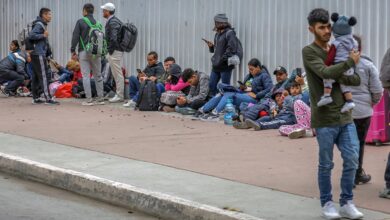U.S. Border Patrol’s Century-Long Legacy of Failure and Controversy

As the U.S. Border Patrol celebrates its centennial, its history is marred by accusations of civil rights violations and failed immigration policies. Critics argue that the agency remains plagued by abuses and inefficiencies despite increased funding and technology.
This month, the U.S. Border Patrol commemorates a century of border surveillance, marked by a history of challenges and accusations of civil rights violations. Defenders of migrant rights criticize the agency’s record and the political influence wielded by its union.
Founded on May 28, 1924, with just 450 officers, the Border Patrol has grown to nearly 20,000 members tasked with the crucial responsibility of guarding the U.S.-Mexico and U.S.-Canada borders and overseeing American seaports and airports. Initially staffed by members of the Texas Rangers and local sheriff’s departments familiar with the terrain and life along the Mexican border, the early agents received a badge, a gun, an annual salary of $1,680, and the requirement to provide their own horses.
The Border Patrol was created during a period of heightened xenophobia and nativism in the United States. In its early years, the agency focused on preventing the entry of Chinese immigrants, later expanding its efforts to include Mexican migrants. The agency’s foundations were steeped in racial profiling and discriminatory practices, a culture that critics argue persists to this day.
Following World War II, the demand for migrant farm workers dwindled, leading to increased resources for the Border Patrol to curb immigration. Despite its significant role, Border Patrol agents, often described as the “first line of defense,” have faced scrutiny from humanitarian organizations for alleged abuses amidst America’s faltering immigration policies.
Over the years, the Border Patrol has been accused of numerous abuses, including beatings of migrants, sexual assaults on women, drug trafficking, and the use of lethal force. Vicki Gaubeca, a director at Human Rights Watch, highlights the agency’s “questionable beginnings” rooted in racism and racial profiling, where even U.S. citizens were arrested based on their skin color. She criticizes the ongoing culture within the agency, noting, “Many times the excuse is the same, agents were defending themselves from a ‘rock attack,’ but I have always said that the damage caused by a rock cannot be compared to that of a bullet.”
Between 1980 and 1990, the Border Patrol tripled its budget and workforce, integrating more technology such as infrared cameras and motion sensors. The terrorist attacks of 2001 further increased the agency’s resources, now boasting robot dogs and unmanned drones for border surveillance. In 2003, the Border Patrol became part of the U.S. Customs and Border Protection (CBP), which has an annual budget of $25 billion.
Political Power and Influence
The Border Patrol’s political influence has grown, mainly since its union supported former President Donald Trump in the 2016 election. Since then, the union has backed political candidates at all levels, especially those advocating for increased border security. Gaubeca questions the unique status of the Border Patrol’s union, noting that federal agencies like the FBI and DEA do not have unions. “No other federal agency has a union, especially given their role in national security,” she stated.
Maria Salazar, representing the group Victims of the Border Patrol, has questioned the deaths of migrants at the hands of agents, highlighting that even U.S. citizens are among the victims. “They hide behind the law and have never been held accountable for their actions,” Salazar remarked.
According to a recent report by the Government Accountability Office (GAO), an independent watchdog, since 2010, Border Patrol’s internal investigation units have responded to nearly 900 “critical incidents” involving their agents, including 149 fatal encounters. These units have been accused of obstructing justice, leading to President Joe Biden’s administration dismantling them. Videos showing agents destroying water and food supplies left by humanitarian groups for undocumented migrants in the Arizona desert have sparked outrage for years.
Gaubeca and Salazar argue that the lack of independent oversight over the Border Patrol is a significant issue. The agency is often left to investigate itself in cases of alleged abuse, leading to a lack of accountability and justice for victims.
Historical Failures and Modern Challenges
The failures of the Border Patrol are not just contemporary issues but are deeply rooted in its history. Latin America, particularly Mexico, has borne the brunt of these policies. The U.S.’s approach to immigration has often been characterized by a fluctuating need for labor and a simultaneous desire to control and limit migration. This contradiction has led to cycles of labor importation during economic booms and harsh crackdowns during downturns.
Programs like the Bracero Program, which brought Mexican laborers to the U.S. during World War II, highlight this complex relationship. The end of such programs often led to increased efforts to curb immigration, with the Border Patrol at the forefront of these initiatives.
The impact of the Border Patrol’s practices on migrant communities cannot be overstated. Reports of physical abuse, psychological trauma, and even death at the hands of Border Patrol agents paint a grim picture of the agency’s enforcement methods. Migrant advocates argue that these practices violate fundamental human rights and undermine the U.S.’s moral standing.
The militarization of the border has also had significant socio-economic impacts on border communities. The presence of heavily armed agents, surveillance technology, and physical barriers has disrupted the daily lives of residents, many of whom have familial and economic ties that straddle the border.
Moving Forward: Reform and Accountability
Comprehensive reforms are necessary to address the systemic issues within the Border Patrol. These should include establishing independent oversight mechanisms to ensure accountability for abuses, revising training programs to focus on human rights and de-escalation techniques, and reducing the agency’s militarized approach to border enforcement.
Moreover, immigration policies need a holistic overhaul to address the root causes of migration, such as economic inequality and violence in Latin America. Providing legal pathways for migration and ensuring fair treatment for asylum seekers are crucial steps in creating a more just and effective immigration system.
As the U.S. Border Patrol celebrates its centennial, reflecting on its legacy of failure and controversy is essential. Despite increased funding and advanced technology, the agency remains plagued by abuses and inefficiencies. The political power of its union further complicates efforts for reform.
Also read: Pandemic Deepened Latin America’s Longstanding Educational Crisis and Inequity
The history of the Border Patrol is intertwined with broader issues of immigration and border policy in the United States. Addressing these issues requires reforming the agency and rethinking the U.S.’s approach to immigration as a whole. Justice, accountability, and human rights must be at the forefront of these efforts, paving the way for a fairer and more humane immigration system.





